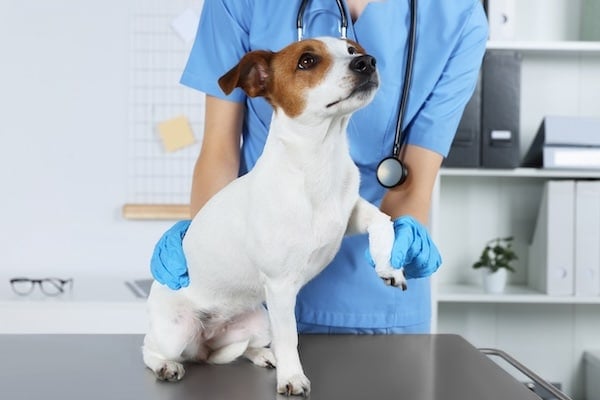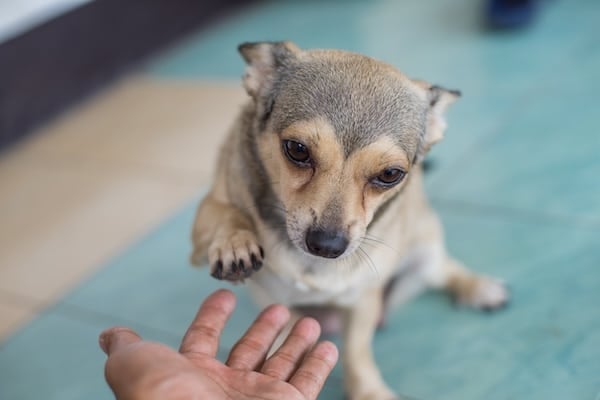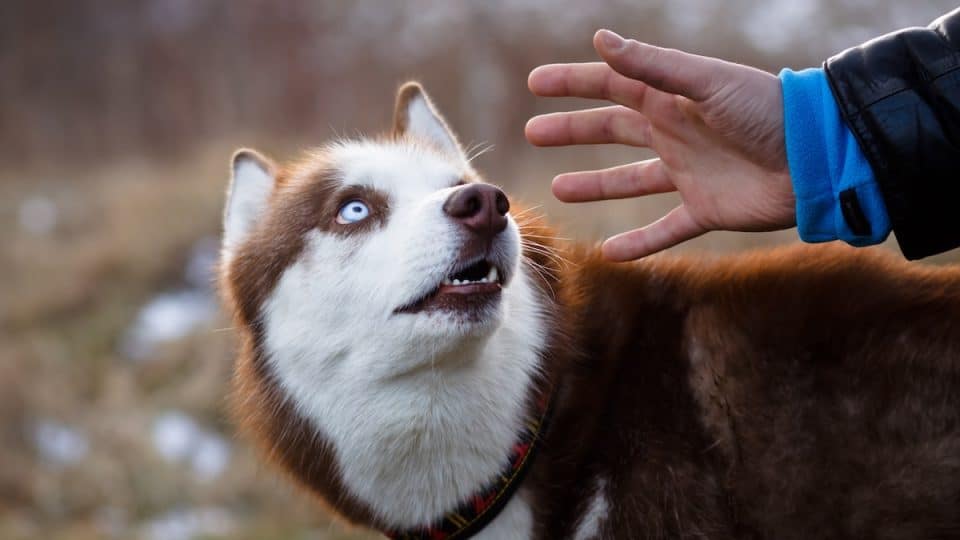- Not a substitute for professional veterinary help.
Dogs, just like people, have unique preferences when it comes to touch. While some may love pets and cuddles, others can be sensitive to handling, especially around their paws and collar. If your dog has touch sensitivity, you might notice they flinch, whine, or avoid being touched altogether.
This discomfort with touch can stem from past negative experiences, injuries, limited socialization, or a lack of handling as a puppy. It might cause challenges with vet visits, grooming, and traveling.
To learn how to navigate touch sensitivity in dogs, we consulted two trainers: Annie-Mae Levy, a professional dog trainer and behaviorist at Woofz, and Paige Gordon, a certified professional dog trainer at Spirit Dog Training. In this article, we’ll explore the causes and signs of touch sensitivity, plus how to help dogs feel more comfortable with—and even enjoy—being touched.
Reasons a Dog Is Sensitive to Touch
To determine if your dog is okay with touch, trainer Paige Gordon advises adding plenty of pauses between petting. “If they move towards you, bump your hand with their head, or paw at you, this is usually a sign they’d like the affection to continue,” says Gordon. On the other hand, if they move away, freeze, or growl, they’re probably uncomfortable with it.
If your dog is sensitive to touch, there could be several factors at play, including:
- A background of abuse. Dogs who have a past of being harshly handled or punished may be wary of being touched by humans.
- Inadequate socialization. Gordon notes that some dogs may not have received adequate socialization or handling when they were puppies. Body handling from an early age is essential for comfort and confidence.
- Breed. Trainer Annie-May Levy notes that some dogs have a genetic predisposition to being less cuddly. Independent breeds like the Shiba Inu might only want to be touched on their terms unless well-socialized at an early age. Breeds like the Greyhound or Chinese Crested have thin skin that may make them more sensitive to touch.
- Environmental factors. Gordon says the weather is another factor to consider. “A big fluffy dog is less likely to be interested in petting and cuddling when it’s very hot out.”
Medical reasons to see a vet about touch sensitivity
If your dog’s sensitivity to touch is new and sudden, Gordon advises taking them for a veterinary exam, as this can be a sign of illness or pain. Desensitization training won’t be effective if touch causes your dog physical discomfort.
Common health-related causes of touch sensitivity include:
- Arthritis. Joint inflammation may cause a negative reaction to touch.
- Hot spots. These inflamed skin lesions usually appear on the head, legs, or hips.
- Skin infections. Bacterial infections, like pyoderma, can make the skin red, swollen, and itchy.
- Allergies. Reactions to allergens, like pollen or certain foods, can irritate the skin, making it sensitive to touch.
- Injuries. Cuts, sprains, or fractures can also make touch painful.
- Dental problems. Periodontal disease can cause sensitivity around the mouth.
- Ear infections. Painful infections in the ear canal often make dogs sensitive around their head.

Liudmila Chernetska via iStock
How To Help a Dog with Touch Sensitivity
Before you jump into handling exercises or desensitization training, here are some ways to help your dog feel more comfortable.
- Check with a vet. Gordon recommends starting with a vet exam to rule out pain or medical conditions that could be causing your dog’s aversion to touch.
- Be aware of body language. If we don’t spot our dogs’ signs of discomfort, like lip-licking, panting, or turning the head away, we can accidentally reinforce touch aversion. It’s a good idea to brush up on dog signs of stress.
- Approach your dog slowly. Sudden movements can make dogs nervous. Slowly approaching helps put them at ease and make them more open to touch.
- Tell your dog you’re going to touch them. Using a verbal cue like “ready” helps your dog anticipate your touch. “This kind of predictability can make a significant difference in how your dog reacts,” explains Levy.
- Give your dog space. Gordon encourages pet parents to respect their dog’s personal space, especially when they’re resting.
- Inform guests of your dog’s sensitivity. Gordon also recommends ensuring any house guests or strangers understand your dog’s discomfort with being touched.
- Work with a behaviorist. If your dog’s sensitivity is severe, Levy emphasizes that working with a certified animal behaviorist could be beneficial.
Paw Handling Exercises
Handling exercises are one of the best ways to help your dog through their touch sensitivity. Paw handling exercises offer an especially good example of how it works.
Paws are one of the areas that we most often need to handle on our dogs—and also one of the areas many dogs least enjoy having handled.
“Usually, this stems from a nail trim where someone has accidentally cut too close to the quick and caused pain,” Levy explains. Dogs who have experienced any type of paw injury may be hesitant about someone touching their feet. It might also be simple lack of exposure—if dogs don’t get used to having their paws handled, Gordon says they’ll often be uncomfortable with that kind of touch.
Teaching your dog to “give a paw” or “shake” is a great place to start. This exercise gives your dog agency (they make the choice to put their paw in your hand), and it helps them build a positive association with having their feet touched.
Levy lays out the steps:
- Put high-value treats in your fist.
- Place your fist on the ground and wait.
- Most dogs will investigate by licking and mouthing your hand. Eventually, they’ll use their paws to get at the treat.
- The second your dog touches your hand with a paw, mark the action with a clicker or phrase and open your hand so they can access the treat.
- Repeat.
Once your dog becomes good at giving you their paws, Gordon says you can begin touching and handling them for brief periods. Usually, this will start with brushing a single finger over the paw. Gradually, you can build up duration and pressure until you can easily examine their paws.

Emodpk via iStock
Desensitization Training for Touch
If your dog shows signs of discomfort with touch generally, desensitization training and counterconditioning are a good place to start.
Desensitization training is all about baby steps: you expose your dog to a frightening stimulus in a way that’s so mild that they never get overwhelmed. With counterconditioning, you reward your dog for the experience, replacing a negative feeling with a positive one. Eventually, with time and practice, your dog’s tolerance for the stimulus they don’t like grows.
Here’s what touch desensitization might look like:
- Identify your dog’s touch threshold. Find how much touch your dog can comfortably tolerate before they show signs of stress or move away.
- Start small. Touch your dog lightly, in a way they can tolerate, and pair the touch with positive reinforcement like a treat and praise. When the treat is gone, pull your hand back.
- Increase intensity. Once your dog is consistently comfortable, increase either the duration or the gentle pressure of your touch, once again rewarding with a treat and praise. Repeat until your dog is consistently comfortable.
- Don’t be afraid to take a step back. If at any point your dog shows signs of stress, go back to the previous intensity.
- Keep sessions short. Even five minutes can be a lot for handling practice. A few short, positive rounds every day is better than one long.
Desensitization and counterconditioning are a form of behavior modification training—which is one of the hardest aspects of dog training to practice. If you’re struggling, consider calling in an experienced positive-reinforcement trainer who can help you build a plan and offer tips.
Though your dog may never be a cuddle bug, time and patient practice can help many dogs learn to tolerate handling enough to allow for care, grooming, and the occasional ear rub.



